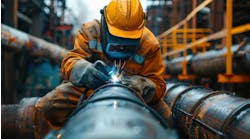Latest from Management
Have We Reached Critical Mass in the Trades?
Sponsored
Radiant heating and cooling ceiling systems for the hydronics contractor
This is my second column in a series of articles about radiant ceiling heating and cooling systems. My next experience with radiant ceilings was an artistic radiator that I built and installed in my home office basement. It was similar to a panel radiator, except that it was completely made of copper.
It was a 4-ft. x 4-ft. radiator. It was made of ½-in. copper pipe, with 12-in. wide copper sheeting applied to the tubes with an epoxy adhesive. It was quite beautiful, at least in my eyes. I mounted it directly in the middle of the room and piped it parallel reverse return.
I remember sitting directly below it during “design” conditions, and although I could feel some heat radiating off of the shiny copper surface, it really didn’t feel as warm as I thought it should have. I happened across an article by my good friend Dan Holohan in which he spoke of an article he had discovered pertaining to ideal radiator covers and the ideal color for a radiator.
It seems that way back when, the thought was to color the radiators a bright metallic color, like gold, silver or copper. Then along came some scientific types who discovered what is known as emissivity, or the ability of a surface to emit radiant energy.
It seems that early thoughts about color were actually somewhat incorrect; shiny metallic paint colors suppressed the ability of a heated surface to send out radiant energy waves. Interestingly enough, when they tested non-metallic colors, they saw a significant increase in the emissivity of a heated surface.
Oddly enough, many of these painted radiators worked just fine, indicating that they were significantly oversized in the first place. Not a real surprise given that there was still a lot of experimentation going on at that stage of the game. It actually became a standard recommendation in situations where overheating was occurring to paint the offending radiators a metallic color to help suppress their output.
Back to my beautiful copper colored radiant ceiling panel radiator; I decided to see if I could increase its output so I connected a temperature recording differential thermometer across the supply and return lines, and I painted the shiny surface of the copper radiator flat white (latex).
The temperature differential across the radiator doubled from 3°F to 6°F. It made a big difference in the feeling of the office, and it felt like I was sitting underneath a heat lamp at design conditions. Ah, yes, true radiant comfort.
The room absolutely felt much warmer after my modified paint job. It was an eye-opening experience.
After that experience, I had the opportunity to place numerous other commercially manufactured radiant panel heaters on ceilings during my tenure in the field, and whenever I had a chance I always asked the consumer during subsequent service call visits what they thought about their radiant ceiling heaters. Without fail they all said they loved their ceiling-mounted radiators and wondered why they hadn’t done it sooner.
About the only real objection was regarding physical aesthetics; there’s really not much that can be done to hide a European-style panel radiator that is mounted onto a finished ceiling. They did say that the comfort levels within the room were significantly better than it was before with the forced air distribution system that it replaced.
The aesthetic issue was not really a deal killer, but it did give me cause to look into the possibility of doing a site-built panel radiator that would have a significant output, but would blend into the interior schemes of the home.
Tune in next month as we continue looking at alternative radiant heating surfaces in our efforts to “Grow Radiant.” If you have not yet become a member of the new RPA, by all means go to our website at www.radiantprofessionalsalliance.org and get signed up. It is an inexpensive way to support your industry, which is here to support you!
All Mark Eatherton material on this website is protected by Copyright 2013. Any reuse of this material (print or electronic) must first have the expressed written permission of Mark Eatherton and CONTRACTOR Magazine. Please contact via email at: [email protected].
Mark Eatherton
Mark Eatherton material on this website is protected by Copyright 2017. Any reuse of this material (print or electronic) must first have the expressed written permission of Mark Eatherton and CONTRACTOR Magazine.

